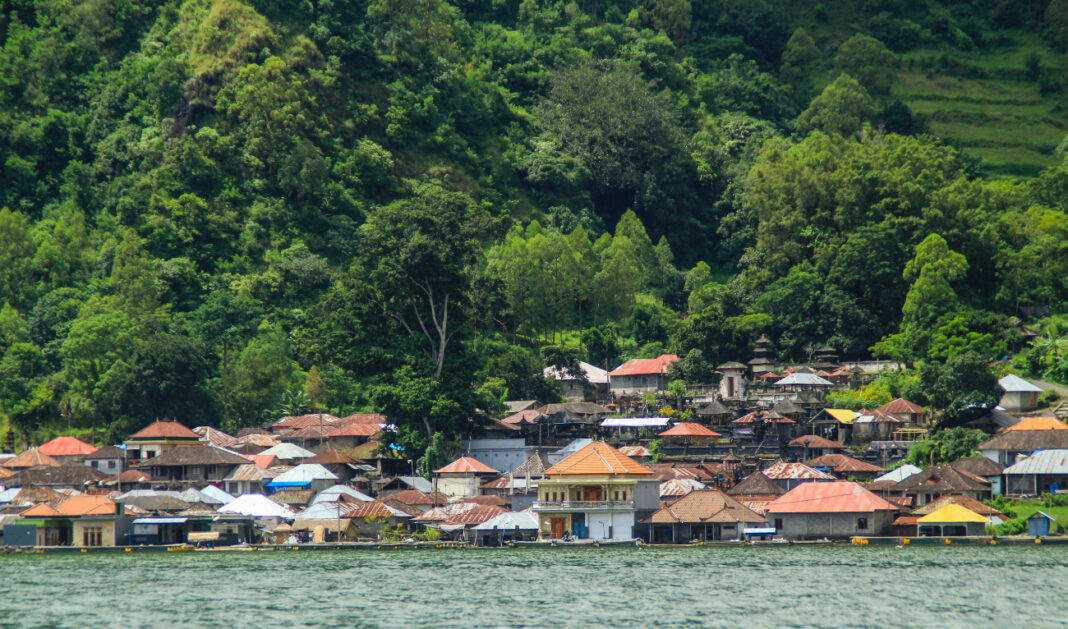BALI: In Bali’s highland village of Trunyan, corpses are laid out at the foot of a fragrant banyan tree and left to decompose in the open air. A villager who died almost two months ago is the latest member of the lakeside cemetery, where the centuries-old funeral tradition has remained alive despite the ongoing COVID-19 pandemic.
“You can still see the face,” village resident and local guide Ketut Mawon told Arab News on a recent visit. He was pointing to a corpse that was dressed in traditional Balinese clothing and with a face that appeared to be intact.
To reach Trunyan, one must take a 15-minute boat ride from the main road to reach the other side of Batur crater lake.
In this northeastern side of Bali live the Bali Aga people, known for their unique and sacred funeral rite where the bodies of the deceased are left above ground under a banyan tree, which they believe absorbs the pungent smell of decaying bodies.
Even as the global COVID-19 pandemic has forced drastic changes to funeral rituals around the world, a solemn send-off as they’ve always known remains an option for Trunyan villagers.
The public health crisis meant corpses had to be wrapped in layers of plastic, before being placed inside a body bag, and then a casket. The transformed ritual often denied family members a chance to care for the bodies of their loved ones one last time, leaving instead a quick burial performed by undertakers clothed in full protective gear designed to prevent the spread of coronavirus.
However, the people of Trunyan still ride their canoe to reach the nearby cemetery, which is only accessible by boat and only permits men to take part in the ceremony.
“The pandemic has not changed any of the rituals, but we do wear face masks and maintain our social distancing from one another,” Mawon said.
In the secluded cemetery, each corpse is partially shielded by a small woven bamboo cage. Despite the visibly decaying bodies and bones, there was no putrid smell. Coins, bank notes, snack packaging and other daily necessities, as well as photos of the deceased, are left scattered around the site, placed there by family members for the dead to take to the afterlife.
While their skeletons are scattered on the ground, the skulls are stacked on top of a nearby stone altar. When there is no room left, the oldest of the corpses are removed to a nearby ossuary to allow space for new corpses.
“This cemetery is assigned only for 11 corpses. If there are less than that, it is fine, but it cannot be more than that. It is what our ancestors have told us,” Mawon said.
To be granted a final resting place at the special cemetery, the deceased must fulfill certain conditions: They must either be village priests, or have died of a natural cause and be married. Of the 11 spots, four are assigned for the village priests, with the bamboo shacks marked by a white cloth cover.
A separate cemetery is located not too far away, and is especially assigned for babies and those who are unmarried. There is also another space for those who died of unnatural causes, or whose bodies are scarred.
“In the second cemetery, the corpses are left also in the open but there is no fragrant tree there so they smell, but in the third one, we bury them,” Mawon explained.
In October, two villagers died under a landslide following a 4.8-magnitude earthquake that struck Bali. They were among those buried in the third cemetery, according to Mawon.
Every five years, the villagers perform the last part of Balinese funeral ritual known as Ngaben, a final send-off for the souls on to the next life. However, the version carried out by Trunyan residents is a little different.
“Unlike the rest of the Balinese, we don’t cremate the effigies in our Ngaben ceremony, but we float them along with their belongings that are left scattered here to the lake,” Mawon said.
The Bali Aga people are Bali’s indigenous people, whose ancestors are believed to predate the 16th-century Majapahit empire.
Their unique funeral rites were quite the tourist attraction, especially among foreign visitors. Up to 20 boats each carrying eight passengers made their way to the cemetery every day, before the pandemic.
In 2019, more than 6 million international travelers visited Bali.
“After the pandemic hit, we only had local visitors,” Mawon said.
Though Bali’s international airport has been officially open for foreign visitors since mid-October, the island has yet to welcome an international direct flight. The relatively few foreigners visiting Bali have instead arrived in Jakarta with a special business visa, before continuing the trip on a domestic flight to the province.
The popular holiday destination has instead seen a surge of domestic tourists holidaying for Christmas and New Year, but calls for a change in the requirements for international arrivals are mounting still.
Bali Deputy Governor Tjokorda Oka Artha Ardhana Sukawati is among those urging the central government in Jakarta to reevaluate current requirements.
“We don’t mean to differentiate, but the market segment is different. Domestic tourists are concentrated in southern Bali,” Sukawati said during a panel discussion on Dec. 17, “while foreign tourists, their stay is more distributed (in other parts of Bali).”




